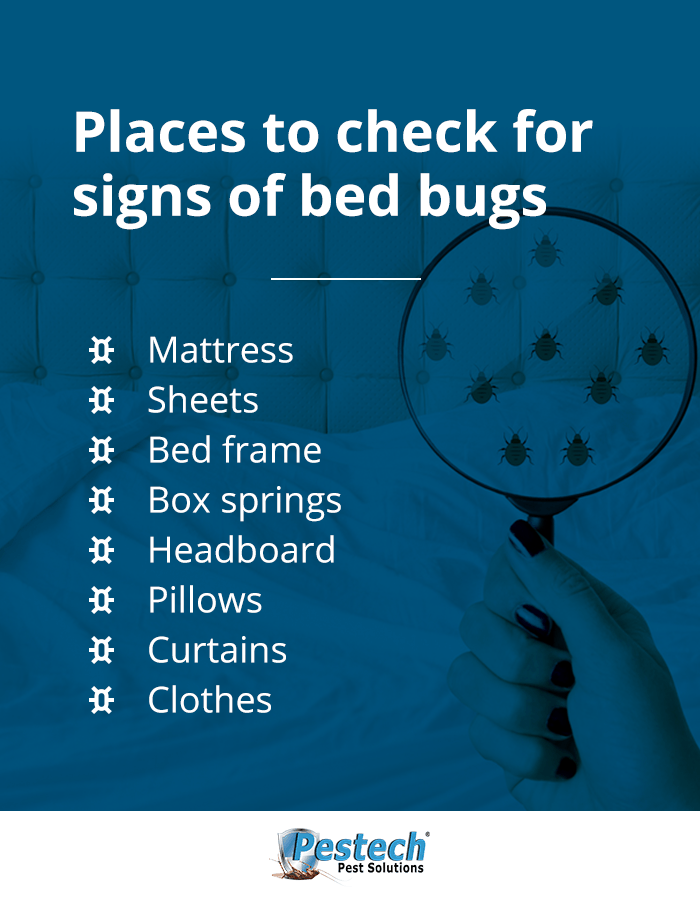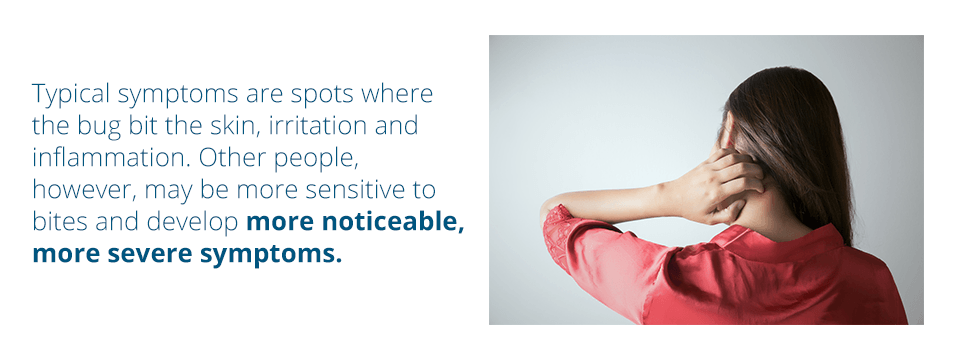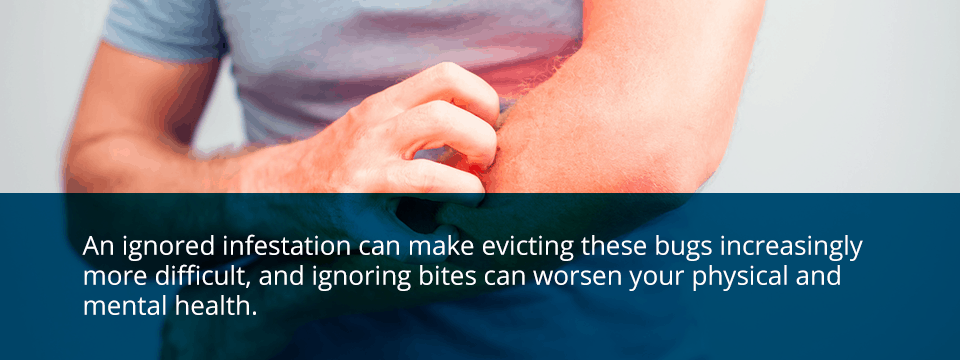How to Identify Bed Bug Bites

Bed bugs are tiny parasites that feed on blood from humans and other warm-blood animals, though the two main species of bed bugs prefer human hosts. Bed bugs get their name from their preferred habitats in mattresses, sofas, clothing and other soft human furnishings, especially dark spaces. Bed bugs can cause a panic when found in dwellings, such as private homes, hotels, dorms, army barracks, shelters and cruise ships. However, these bugs do not transmit diseases through their bites.
When people are bitten by bed bugs, they typically experience itchiness, irritation or sores. If you’re dealing with bed bugs, how can you treat them? Can bed bugs be prevented? How do you know if your symptoms are from bed bugs or another cause? Fortunately, you can reduce your chances of getting bitten by bed bugs, and there are also several treatment options, including antihistamines and good hygiene.
To help you when it comes to recognizing and treating bed bug bites, we have put together this guide on identifying bed bug bites.
Contents:
- Where to Find Bed Bugs
- Where Bed Bugs Will Bite
- Symptoms of Bed Bug Bites
- Common Misidentifications of Bed Bugs and Bites
- What Happens If Bites Are Left Untreated?
- How Do You Treat Bed Bug Bites?
Call our team to schedule an inspection in NY if you suspect bed bugs in your home.
Where to Find Bed Bugs
Most Americans are worried about bed bugs, and many have encountered bed bugs. Because bed bugs can infest so many different locations, they pose a threat to a lot of Americans.
The most common areas where bed bugs are found include:
- Apartment buildings
- Condominiums
- Rented homes
- Hotels
- Vacation rentals
- Big office spaces
- Hospitals
- Nursing homes
- Cruise ships
- Daycares
- College dorms
- Malls
- Urban areas
- Secondhand or furniture stores
- Public transportation, such as airplanes

Bed bugs can be transferred on used furniture, luggage, bedding, bedclothes, storage boxes, moving boxes, shipped items and chairs or recliners where people may sleep. Places with a lot of traffic, such as hotels, are particularly susceptible to infestations, especially if they are not cleaned properly.
Typical Areas Where Bed Bugs Will Bite
Bed bugs typically seek shelter in dark crevices and cracks and feed on hosts while they are sleeping. Their peak feeding time is between midnight and 5 a.m., and they need to feed regularly to survive and reproduce. Though their bites tend to be seen quickly, they may also take up to two weeks to become visible.

Bed bugs will bite anywhere on your body there is skin, though they will typically target areas that are exposed while you are sleeping, including:
- Your legs
- Your arms
- Your hands
- Your neck
- Your face
- Your shoulders
Symptoms of Bed Bug Bites
Most people don’t feel the bite when it occurs. Typical symptoms are spots where the bug bit the skin, irritation and inflammation. Other people, however, may be more sensitive to bites and develop more noticeable, more severe symptoms. If further irritation doesn’t occur, symptoms will typically subside within a week.
Unfortunately, because bed bugs don’t necessarily feed every night, it can take weeks before people notice a larger pattern. Symptoms can also vary from person to person, so the lack of a telltale sign makes identifying the bugs particularly challenging. In fact, some people don’t show symptoms at all, even after they’ve been bitten. This can create confusion with two people sleeping in the same bed after one person shows signs of bites, but the other person doesn’t.
Aside from inflammation and itchiness, there are a few more signs of bed bug bites. Here’s how to tell if you have bed bug bites:
- A painful, burning sensation
- An itchy red bump that has a dark center and a lighter swollen surrounding area
- An itchy bump that has a clear center
- Areas of skin with flat or raised patches that might be inflamed
- Small welts or red bumps in a line or zigzag pattern
- Tiny spots of dried blood from bites or stained bed clothing or sheets
- White or transparent skins that have been shed by the nymphs
- Reddish-brown stains on fabrics from bed bug droppings
How the bite manifests in a human host depends on the characteristics of the person and the bug’s bite. People rarely experience severe symptoms and reactions to a bed bug bite, but there are a few serious symptoms that do require medical attention (usually if the person has an allergic reaction to the bite):
- Blisters
- Nausea
- Fever
- Anaphylaxis
- Difficulty breathing
Additional health complications can also be caused by living with bed bugs, such as:
- Sleep deprivation
- A decrease in wellbeing
- An increase in the likelihood of infection
When faced with the possibility that we are being bitten by bugs while we sleep, we tend to avoid sleeping or get only restless, short spurts of sleep. This sleep deprivation results in fatigue and lowered immune functioning and is linked to anxiety and depression. We may also feel a lower sense of self-esteem due to the misconceived correlation between an infestation of bed bugs and a lack of cleanliness. We also face an increase in the likelihood of getting an infection because our skin is being compromised.
If you suspect you are living with bed bugs, take action as soon as possible to rid yourself of these pests.
Common Misidentifications of Bed Bugs and Bites
To be sure you are correctly identifying bed bugs, you’ll want to be able to distinguish between beg bugs and other pests. So what do bed bugs look like?
Young bed bugs, known as nymphs, have a few characteristics in common.
Young Bed Bugs…
- Are smaller than 5 millimeters in length.
- Are not visible without a magnifying glass or microscope.
- Are clear-colored or whitish-yellow.
Nymphs are easier to spot after they have just fed, as the blood in their abdomens gives them a reddish-brown hue. Fortunately, adult bed bugs are easier to see than young bed bugs, and they have several common characteristics.
Adult Bed Bugs…
- Are the size of an apple seed.
- Are about 5 to 7 millimeters in length.
- Bodies are oval-shaped and flat unless they have fed recently.
- Have a shell that is a light-brown, reddish-brown or tan color, depending on when they last fed.
- Release a stale-sweet or musty scent through glands on their underbellies
- Have an antenna with four parts, three segments, unusable wings and short yellow hairs.
There are also common signs and characteristics of bed bug eggs.
Bed Bug Eggs…
- Are located in the same spots that females rest.
- Resemble tiny barrels in shape.
- Are pearl-colored.
- Cause an eyespot develops within a few days.
- Are about the size of the head of a pin.
On average, female bed bugs produce a minimum of 345 eggs during their lifetime.
Female bed bugs laying eggs feed more often and in greater quantities to support their offspring, so it’s important to correctly identify bed bugs as quickly as possible.
Many people confuse bed bugs with other pests or health problems.
Some common misidentifications of bed bug bites include:
- Chickenpox
- Rash
- Fleas
- Mosquito bites
- Hives
- Spider bites
When it comes to these health issues, the symptoms can appear quite similar. Both fleas and bed bugs cause the formation of red bumps on your skin and can be quite itchy. However, fleas tend to bite on the lower half of a person’s body and in warm, moist areas, such as your legs, armpits, feet, elbows and knees.
Mosquito bites can appear similar to both, but mosquito bites tend not to form a pattern, while bed bug bites will generally show up in a line. Hives also show up as red bumps on your skin and can be itchy, though these bumps tend to grow, spread and change shape over a short length of time. Lastly, people sometimes mistake bed bug bites for spider bites, but spiders tend not to bite more than once and spider bites usually take longer to heal compared to other bug bites.
Knowing how these other causes manifest on your body is key to helping you properly identify bed bug bites.
What Happens If Bites Are Left Untreated?

Just as you don’t want to let the infestation of bed bugs go ignored, you also don’t want to let the bites go ignored and untreated. An ignored infestation can make evicting these bugs increasingly more difficult, and ignoring bites can worsen your physical and mental health.
1. Negative Impact on Physical Health
Many people may experience an allergic reaction to chemicals released in a bed bug bite. The common perception is that the symptoms of bed bug bites are limited to swelling, redness and inflammation surrounding the bite marks, but a few people may experience life-threatening reactions if they are allergic to bed bugs.
2. Negative Impact on Mental Health
Bed bugs may cause as much mental harm as they do physical harm, if not more. Bed bugs can cause sleep problems, and create feelings of anxiety as people worry about the bugs in their beds, even for people who haven’t had a history of anxiety problems or trouble sleeping. Coping with bed bugs can be quite overwhelming to many people, so that can take a toll on their mental health.
Bed Bug Bites on Pets
Bed bugs can be parasites to the people in your home, but they can also bite and feed on your pets.
After a pet is bitten by bed bugs, the wounds will most likely heal on their own. In some cases, however, bites can become infected. To address this, schedule an appointment with the vet to check your pet for any infected bites. You will also want to clean your pet’s stuffed toys, bed and any other accessories that bed bugs could be living on. Bed bugs can present a safety concern for everyone in your home, so be thorough when you inspect and clean.
When you hire pest control professionals, you’ll also want to be sure to inform them that you have a pet in your home, as some insecticides are safer for pets than others.
Bed Bug Bites on Children
If you suspect that your child was bitten by bed bugs, you should first treat the bites by cleaning the wounds with water and soap. You also may want to apply a cold compress or some calamine lotion to relieve itchiness. If a child scratches at the bites, they could face further health complications.
Before administering oral antihistamines or topical steroid creams to treat bed bug bites, you should speak with your child’s doctor or pharmacist, as some medications aren’t safe for young children or babies. If they are old enough to understand and follow instructions, direct your child to avoid scratching the bites. You may be able to help them prevent scratching by covering their bites with bandages and by trimming their nails.
After treating the bites on your child’s skin, you should check their mattress, sheets, bed frame, box springs, headboard, pillows, curtains, clothes and any baseboards for signs of bed bugs. You may also want to check the carpeting around the baseboards, seams or cracks in the furniture and the spaces between electrical outlet plates and behind light switches. Look for the bugs themselves, drops of blood or bug droppings.
To contain the infestation until professionals are able to arrive, you can:
- Wash your clothes, drapes and linens at the hottest available setting in both your washer and dryer.
- Steam-clean and vacuum the floors, furniture, mattresses and appliances.
- Fill the cracks in your furniture and gaps surrounding your baseboards with caulking.
- Seal in plastic bags any belongings that cannot be washed and store them for several days at zero degrees or for multiple months at a warmer temperature.
- For items that can be heated safely, heat them to 115 degrees.
Insecticides may also be available to exterminate the bed bugs, but we recommend allowing professionals to bring and use insecticides.
How Do You Treat Bed Bug Bites?
For even mild bed bug bites, there aren’t many treatment options. First, clean the wound with soap and water. If you’re dealing with itchy bites, then you may be able to alleviate your minor symptoms with:
- Antihistamines
- Anti-itch creams
- Over-the-counter hydrocortisone
Most wounds will heal in a week or two on their own. If you are dealing with serve itchiness, swelling or inflammation, however, you should seek medical attention.
Dramatic immune responses can be a sign of an allergic reaction, and in these cases, you may need to administer:
- Epinephrine medication
- Injectable corticosteroid
- Antihistamine
You may also be prescribed antibiotics if an infection occurs. Severe itchiness can lead to infection or scarring, so you may be prescribed antihistamine pills or corticosteroid creams.
Of course, these treatments are for the symptoms you experience after a bed bug bite. To rid your home of bed bugs, you’ll want to contact professionals who can correctly identify the parasite and completely remove or destroy the eggs.
Get Rid of Bed Bugs With Pestech Pest Solutions

At Pestech Pest Solutions, we’ve been keeping pests in line since 1989. We are a family-owned and operated business, and we have a reputation for great customer relations and outstanding service. Our 100% satisfaction guarantee means even the most challenging pest problems are solved. After more than 25 years in the business, we’ve seen at all, and we’re confident that we can solve your pest problems.
Do you have a pest issue that needs solving? Contact us or call us at 800-287-BUGS today to find out what we can do to help you. Or if you have any questions that need answering, we are just a phone call away.
